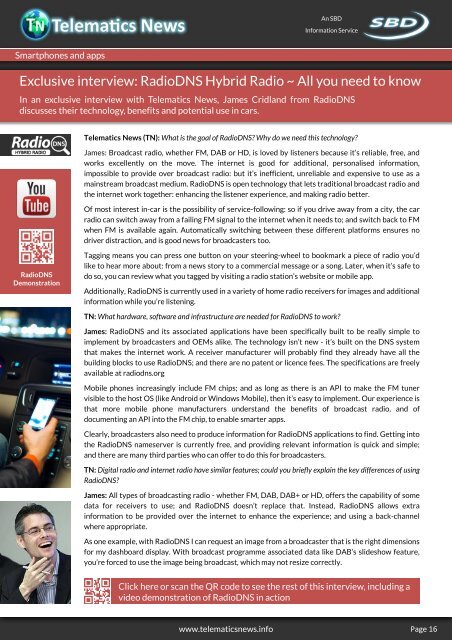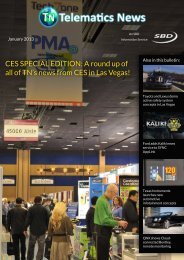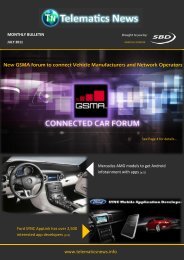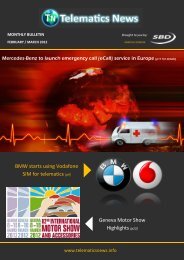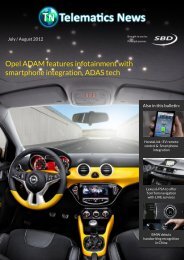to download as PDF. - Telematics News
to download as PDF. - Telematics News
to download as PDF. - Telematics News
Create successful ePaper yourself
Turn your PDF publications into a flip-book with our unique Google optimized e-Paper software.
Smartphones and apps<br />
An SBD<br />
Information Service<br />
Exclusive interview: RadioDNS Hybrid Radio ~ All you need <strong>to</strong> know<br />
In an exclusive interview with <strong>Telematics</strong> <strong>News</strong>, James Cridland from RadioDNS<br />
discusses their technology, benefits and potential use in cars.<br />
RadioDNS<br />
Demonstration<br />
<strong>Telematics</strong> <strong>News</strong> (TN): What is the goal of RadioDNS? Why do we need this technology?<br />
James: Broadc<strong>as</strong>t radio, whether FM, DAB or HD, is loved by listeners because it’s reliable, free, and<br />
works excellently on the move. The internet is good for additional, personalised information,<br />
impossible <strong>to</strong> provide over broadc<strong>as</strong>t radio: but it’s inefficient, unreliable and expensive <strong>to</strong> use <strong>as</strong> a<br />
mainstream broadc<strong>as</strong>t medium. RadioDNS is open technology that lets traditional broadc<strong>as</strong>t radio and<br />
the internet work <strong>to</strong>gether: enhancing the listener experience, and making radio better.<br />
Of most interest in-car is the possibility of service-following: so if you drive away from a city, the car<br />
radio can switch away from a failing FM signal <strong>to</strong> the internet when it needs <strong>to</strong>; and switch back <strong>to</strong> FM<br />
when FM is available again. Au<strong>to</strong>matically switching between these different platforms ensures no<br />
driver distraction, and is good news for broadc<strong>as</strong>ters <strong>to</strong>o.<br />
Tagging means you can press one but<strong>to</strong>n on your steering-wheel <strong>to</strong> bookmark a piece of radio you’d<br />
like <strong>to</strong> hear more about: from a news s<strong>to</strong>ry <strong>to</strong> a commercial message or a song. Later, when it’s safe <strong>to</strong><br />
do so, you can review what you tagged by visiting a radio station’s website or mobile app.<br />
Additionally, RadioDNS is currently used in a variety of home radio receivers for images and additional<br />
information while you’re listening.<br />
TN: What hardware, software and infr<strong>as</strong>tructure are needed for RadioDNS <strong>to</strong> work?<br />
James: RadioDNS and its <strong>as</strong>sociated applications have been specifically built <strong>to</strong> be really simple <strong>to</strong><br />
implement by broadc<strong>as</strong>ters and OEMs alike. The technology isn’t new - it’s built on the DNS system<br />
that makes the internet work. A receiver manufacturer will probably find they already have all the<br />
building blocks <strong>to</strong> use RadioDNS; and there are no patent or licence fees. The specifications are freely<br />
available at radiodns.org<br />
Mobile phones incre<strong>as</strong>ingly include FM chips; and <strong>as</strong> long <strong>as</strong> there is an API <strong>to</strong> make the FM tuner<br />
visible <strong>to</strong> the host OS (like Android or Windows Mobile), then it’s e<strong>as</strong>y <strong>to</strong> implement. Our experience is<br />
that more mobile phone manufacturers understand the benefits of broadc<strong>as</strong>t radio, and of<br />
documenting an API in<strong>to</strong> the FM chip, <strong>to</strong> enable smarter apps.<br />
Clearly, broadc<strong>as</strong>ters also need <strong>to</strong> produce information for RadioDNS applications <strong>to</strong> find. Getting in<strong>to</strong><br />
the RadioDNS nameserver is currently free, and providing relevant information is quick and simple;<br />
and there are many third parties who can offer <strong>to</strong> do this for broadc<strong>as</strong>ters.<br />
TN: Digital radio and internet radio have similar features; could you briefly explain the key differences of using<br />
RadioDNS?<br />
James: All types of broadc<strong>as</strong>ting radio - whether FM, DAB, DAB+ or HD, offers the capability of some<br />
data for receivers <strong>to</strong> use; and RadioDNS doesn’t replace that. Instead, RadioDNS allows extra<br />
information <strong>to</strong> be provided over the internet <strong>to</strong> enhance the experience; and using a back-channel<br />
where appropriate.<br />
As one example, with RadioDNS I can request an image from a broadc<strong>as</strong>ter that is the right dimensions<br />
for my d<strong>as</strong>hboard display. With broadc<strong>as</strong>t programme <strong>as</strong>sociated data like DAB’s slideshow feature,<br />
you’re forced <strong>to</strong> use the image being broadc<strong>as</strong>t, which may not resize correctly.<br />
Click here or scan the QR code <strong>to</strong> see the rest of this interview, including a<br />
video demonstration of RadioDNS in action<br />
www.telematicsnews.info Page 16


